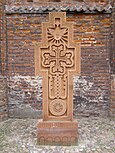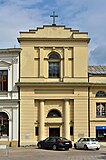Armenians in Poland
This article includes a list of general references, but it lacks sufficient corresponding inline citations. (June 2016) |
Armenians in Slovakia, Armenians in the Czech Republic |
| Part of a series on |
| Armenians |
|---|
 |
| Armenian culture |
|
By country or region |
Armenian diaspora Russia |
| Subgroups |
| Religion |
| Languages and dialects |
|
| Persecution |
|
Armenians in Poland (
History
Origins
About the beginning of the Armenian presence in Poland, Adolf Nowaczyński, a Polish writer, gives us the following sketch of the Armenians of Poland:
Long before the fall of the (Armenian)
Galicia.The first dismemberment of their country brought about a great emigration. The Armenian emigrants, taking with them a handful of native soil in a piece of cloth, were scattered in southern Russia, into the Caucasus, in the land of the Cossacks, while 50,000 from among them came to Poland. From then on, new streams of Armenian emigration periodically proceeded from the shores of Pontus towards the hospitable country of the Sarmatians, and it must be said that these guests, coming from such a distance, proved themselves really 'the salt of the earth,' an exceedingly useful and desirable element. They settled mostly in the cities, and in many places they became the nucleus of the Polish bourgeois class.
Ties to Lwów

The city of
, the forebears of the Alexandrovics, the Augustinovics, the Agopsovics and Apakanovics took part. Also from their ranks came forth later renowned Poles, such as the Malowski, Missasowicz, Piramowicz, Pernatowicz, Jachowicz, Mrozianowski, Grigorowicz, Barowicz, Teodorowicz, among others.The growth of Poland's Armenian community

Through successive immigrations, the Armenians of Poland gradually formed a colony, comprising 5,000.
In 1516 King
Ties to the Armenian community in the Romanian lands
Armenians in
Around 10,000 of the L'viv Armenian community who had settled in
When
Intermarriage and assimilation
The Armenian origins of many Polish families can be traced to before
Malyi Virmeny which translates to "Little Armenia" in
Polish-Armenians in the 20th century
At the beginning of the 20th century, there were about 6,000 Armenians in Poland living mostly in
After suffering heavy losses along with the rest of Poland's population in
To combat this dispersion they began to form Armenian Cultural Associations. Additionally, the
A number of cultural and artifacts of Armenian culture can still be found within Poland's present-day borders, particularly in the vicinity of
Armenians today
Most Armenians living in Poland today origins are from the post-Soviet emigration rather than the older Armenian community. After the Soviet Union's collapse, thousands of Armenians came to Poland to look for the opportunity to better their life. It is estimated that between 40,000 and 80,000 Armenians came to Poland in the 1990s, (many of them returned to Armenia or went further West, but up to 10,000 stayed in Poland), with only about 3,000–8,000 from the so-called 'old emigration'.
The Foundation of Culture and Heritage of Polish Armenians was established by the Ordinary of the Armenian-Catholic rite in Poland, Cardinal
The
There are also now schools in Poland that have recently opened or added on courses that teach Armenian language and culture either on a regular or supplementary basis in Warsaw and Kraków.
Notable Poles of Armenian descent
- Simeon of Poland (1584–1639), traveler and writer
- Kajetan Abgarowicz (1856–1909) — writer
- Fr. Karol Antoniewicz (1807–1852) — Catholic priest, Jesuit and poet
- Teodor Axentowicz (1853–1938) — painter
- Anna Dymna (b. 1951), actress
- Zbigniew Herbert (1924–1998) — poet and essayist
- Fr. Tadeusz Isakowicz-Zaleski (1956–2024) — Catholic priest, shepherd of the Armenian Rite faithful in southern Poland, historian, charity worker and independence activist during communist rule
- Jerzy Kawalerowicz (1922–2007) — film director
- Robert Maklowicz(b. 1963) — journalist
- Krzysztof Penderecki (1933–2020) — composer
- Fr. Grzegorz Piramowicz (1753–1801) — Catholic priest, educator and philosopher
- Juliusz Słowacki (1809–1849) — poet
- Szymon Szymonowic (1558–1629) — poet
- Abp. Józef Teodorowicz (1864–1938) — Armenian Catholic Archbishop of Lviv, renowned for his religious and social work.
- Sonia Bohosiewicz (b. 1975) — actress
See also
References
- ^ a b GUS. "Tablice z ostatecznymi danymi w zakresie przynależności narodowo-etnicznej, języka używanego w domu oraz przynależności do wyznania religijnego". stat.gov.pl (in Polish). Retrieved 2023-10-07.
- ^ "Poland's Armenian community is outstanding manifestation of Diaspora, says Ambassador". armenpress.am. Retrieved 2023-10-07.
- ^ The First Large Emigration of the Armenians – History of Armenia
- ^ Jakubowski, Melchior; Walczyn, Filip; Sas, Maksymilian (2016). "Jazłowiec". Miasta wielu religii. Topografia sakralna ziem wschodnich dawnej Rzeczypospolitej (PDF) (in Polish). Warsaw: Muzeum Historii Polski. p. 68-73. Retrieved 2022-03-18.
- ^ Krzysztof Stopka, Ormianie w Polsce dawnej i dzisiejszej, Kraków 2000
- ^ Website of the Foundation of Culture and Heritage of Polish Armenians







